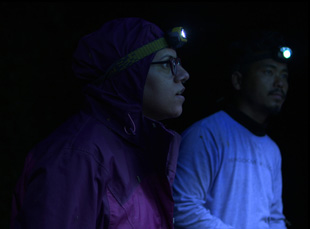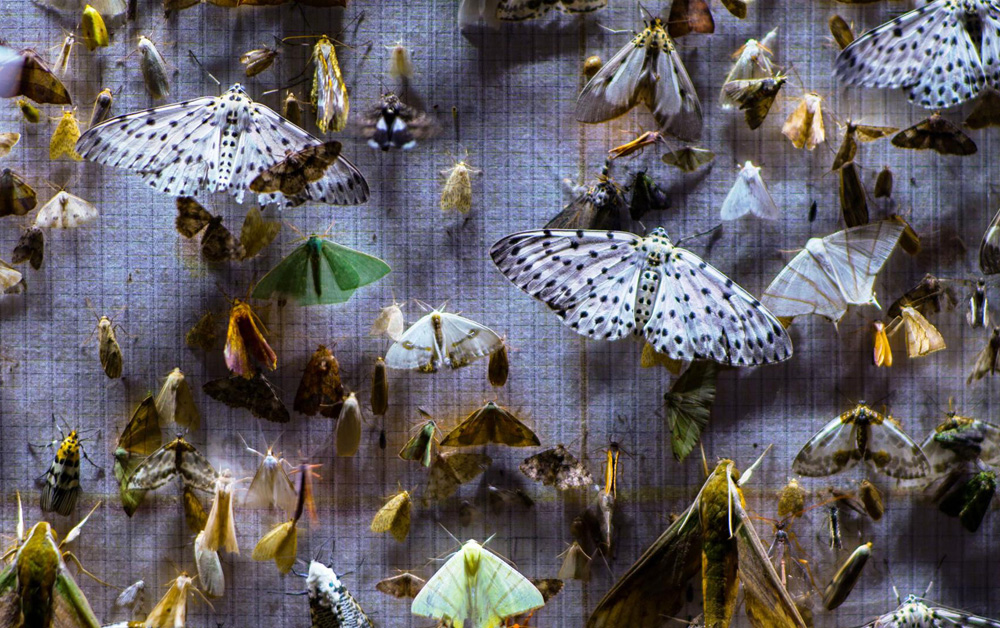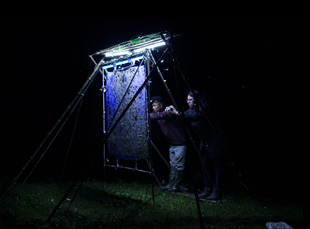“They all look the same to me,” Bicki tells Mansi as they study moths in “Nocturnes,” erecting a wall of light on the side of a mountain in the Eastern Himalayas to attract hundreds to look at up close. Graph paper has been put up to measure the size of wings and Mansi tells Bicki to hone in on the specific strain of hawk moths as they are faced with the unenviable task of counting all that have flown over to the wall, flapping their wings ferociously when as Mansi says they are trying to keep warm. For Bicki, the study is a job, unsure of what’s next when he inevitably has to leave the mountains and move back to the city, but for Mansi, it is a calling, devoting years of her life to one of the smallest creatures on earth when she believes it can reveal so much about the world we live in.
Thanks to Anirban Dutta and Anupama Srinivasan’s own dedication, it isn’t difficult to see why Mansi would be so enraptured, turning any cinema “Nocturnes” plays in into a sacred sanctum, pushing the potential of the medium to truly transport audiences anywhere. The pressure is on Nicki, Mansi and the occasional colleague who joins them as they move slowly up the mountains at 200 meter intervals to learn about the adaptability of the hawk moths to higher climes and can only do so when the moon doesn’t outshine their wall, but Dutta and Srinivasan allow outside observers to luxuriate in a life that moves at a slower pace, filling the eyes and ears with earthly wonders that are too often too easy to look past. Not only does an appreciation grow for nature, but all the effort that goes into creating a scientific fact when Mansi and Bicki brave inclement weather and grueling dusk till dawn marathons of counting moths all to prove just one detail regarding their overall survival as a species, perhaps considered a seemingly inconsequential statistic in the grand scheme of things if the co-directors didn’t so impressively express how all forms of life are tied together.
After winning a special jury award from Sundance earlier this year when its magnificence couldn’t be ignored, “Nocturnes” is now making its way into theaters in the U.S. and while Dutta and Srinivasan are traveling across the country from the film’s recent opening in New York to openings along the Pacific Coast this week, the co-directors spoke about giving audiences the same experience they had, turning their attention completely over to the mountains, bringing the soul of their subjects out and all the sweat that went into creating such a tranquil and gently moving movie.
Anirban Dutta: This came about because both Anu and I live in Delhi, which is an extremely polluted city. Especially during winter, it is very, very difficult to breathe, and many times we have air purifiers on in our homes, and we are just confined to a little bubble because we cannot go out. We are completely disconnected with any little nature that is left in the city, whether it’s the trees or the small parks, we can’t access them anymore and we wanted to make a film that was something that will connect us back to nature because in my childhood, I grew up in a beautiful part of India — Andaman — and my children, who grew up in Delhi, the only world that they were able to access were through their devices, which was deeply disturbing. That’s why we made this film — to reconnect with nature, and it was an invitation for many people like us who had lost that connection.
It is said at one point in the film that the moths come out only for 10 days around the new moon, but I know this was a process that took years. What was it like to figure out how to capture just right?
Anupama Srinivasan: Actually, the 10 days is every month when the artificial lights that the scientists put up are attractive enough to the moths because when the moon’s light is there, their light doesn’t stand a chance. Also during winter, the moths don’t come, so the work of the scientists is restricted to a few months of the the year, so we followed that and it also takes a lot of trial and error for them to figure out where exactly to put the screens, so even their process was for many years and we followed a part of it.
Anirban Dutta: The beautiful part of the scientific work is that it is repetitive, so there’s a rhythm to the work and once we were there and we watched them, we knew exactly what they were going to do and the film was made in a very collaborative way. We knew which elevation they are going to work at, so it was easy for us to set up our camera and to wait for long periods of time for the work to unfold in front of the camera. Once we had the patience to look at their work, then we got the beautiful moments which are there in the film.
Is it true your cinematographer also had a background in entomology?
Anupama Srinivasan: Yeah, we wanted to work with Satya [Nagpaul] because of his very sensitive understanding and response to light and all three of us — Satya, Aniriban and I are very aligned cinematically — that’s the main reason we wanted to work with him, but certainly his love for nature and insects was an added bonus. He really knew a lot about moths.
Just from the shot selection, it seemed like you had a fairly good idea of the visual rhythm of this before you got back to the edit. How early were you thinking about that?
Anirban Dutta: Yeah, the visual idea of the film was pretty much dictated by what the scientists were doing, which was about long periods of observation, waiting, and then minutely looking at things in detail.
Anupama Srinivasan: Having come from the city, we also took a little bit of of time to get used to the rhythms of nature and to appreciate that, so we used to keep editing after every schedule and that helped us refine our cinematic language. The editing was informing the cinematography and vice versa, and we were constantly saying, “Okay, slow down. Let’s look more deeply. Let’s give time to the audience to look.” We had not followed the logistical part of the scientists work much, like they’re packing things or going here and there. We were very clear from pretty early on that our focus was going to be those moments in front of the moth screen because that was the magic and [we were] waiting for that magic.
Everything was a very gradual process of us aligning ourselves with the work of the scientists, with us appreciating the beauty of the moths, allowing ourselves the patience to just hold the shot and see just a little flutter in our shot and not for any great drama to unfold. We wanted to focus on the little things and that’s what got more and more refined, even in the editing process, is how do you take away the didactic, the functional, and the matter of fact things, and keep what is evocative and what really goes at the heart of their work and also of our quest, which was how can we look at the world with more love and attention?

Anirban Dutta: The voiceover of Mansi and her reflections were part of conversation with Mansi over many, many years that we had. These were all ideas that she articulated, and we were very interested in finding a way for that to come into the film. It seemed like a reflective voice diary could be one such tool, and we used to always hear Bikki have these very beautiful conversations with his friends, his allies, his coworkers and we wanted that to come in. Those conversations are happening around the work and those were recorded and found a way into the film.
In general, sound becomes such a crucial element of this as an experience. What was it like to create that spatial environment in the mix?
Anirban Dutta: Exciting. Mixing was definitely a part of it, but before mixing, it was years of recording and meticulous planning to record with a 5.1 immersive microphones, with stereophonic microphones, with 360-degree microphones, and clip microphones to record the minute flutter of the wings of the moth to the walking of the moth on the canvas [of the wall]. So it was a huge archive of sound, which was meticulously captured and logged. And then to bring that into the mixing, we had amazing sound designers and location recordists — Sukanta Majumdar, Shreyank Nanjappa, and Tom Paul and Chris [Stangroom] who worked on the post production of the film. All of the sound team were very much aligned with the vision of the film.
Anupama Srivivasan: Even in the edit, we kept some shots longer because we knew that there was going to be something happening in the sound, so we did a rough sound with the edit, but we knew that more was going to happen in the sound design, so sound was a part of the entire creative process right from the beginning of production.
That level of detail pays off, and I know you’ve not only had this film, but two films go out into of the world this past year. Has this been an exciting time for these long-term projects to be released?
Anupama Srivivasan: Yeah, our previous film, “Flickering Lights” premiered at Busan in 2023 and three months later, we premiered “Nocturnes” at Sundance. So it’s been hectic, but it’s been really wonderful because both films have won a lot of accolades and found a lot of love. And neither of them is a very obvious film in the sense that it’s following any conventional format or template and they’re very different from each other, so we are really absolutely elated that they’ve both found their audiences.
Anirban Dutta: It’s been fantastic because documentary filmmaking is such a long process and sometimes it’s a very lonely process and you just think why have you put yourself through this for so many years. Then when it finishes and you see people reacting to it in cinema halls, it just seems all those years of loneliness and hard work are worthwhile. That’s what it’s been — a worthwhile quest for the last seven to ten years to get these two films out in the world.
Anupama Srivivasan: And with “Nocturnes,” we were really fortunate to have some amazing partners right from the beginning. Sandbox Films and Sundance Institute came on board very early in the process and the fact that we could focus a lot more on the creative process and get it done a bit faster than we did the previous film was immense because the fundraising pressure was a little bit lesser.
We also had a lot of support from the Doc Society and IDFA Bertha and those allies continue to support it [along with] Dogwoof, who is our sales [agent] and Grasshopper Films [our distributor], so we have just fantastic people who are part of this journey and though we are from various parts of the puzzle, it’s been a wonderful journey to find the partners at various points and to make that journey together.
Anirban Dutta: Yeah, and it’s really an honor that our film is getting released [theatrically]. That’s what we dreamt of. This film has been envisioned as a big screen experience and we’re just absolutely thrilled beyond words that people are going to be able to experience it the way we intended. We are just so happy that the audiences will get to see [it] and we would really like to appeal to science teachers and parents and children because here is a film that [families] can come, young and old, and experience and find our connection back to nature.
“Nocturnes” is now open in New York at the Metrograph and opens on October 25th in Los Angeles at the Laemmle Royal before expanding across the country. A full list of theaters and dates is here.





